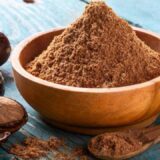Ayurveda Weight Loss– Indian Way To Reduce Stomach Fat
When it comes to losing weight, particularly abdominal fat, many people tend to focus on eating less as the ultimate solution. However, Ayurveda, an ancient Indian system of medicine, offers a different perspective. According to Ayurvedic principles, the key to effective weight loss is not just reducing food intake but eating the right foods tailored to your body’s unique constitution. 
Eating foods that align with your individual needs can help speed up metabolism rather than slow it down, ultimately supporting both weight loss and overall health. Ayurveda emphasizes the importance of mindful eating, choosing foods that not only nourish the body but also promote balance within.
By focusing on the quality and timing of your meals, rather than simply cutting calories, you can achieve lasting, healthy weight loss. This holistic approach addresses the root causes of weight gain, offering a more sustainable path to wellness.
What is Ayurveda?
Ayurveda, derived from the Sanskrit words “Ayur” (life) and “Veda” (science or knowledge), translates to the “science of life.” This holistic system of medicine has been practiced for thousands of years and is based on the philosophy that health is a balance between the body, mind, and spirit.
Ayurveda encourages individuals to live in harmony with nature and focuses on maintaining this balance to prevent illness and promote wellness. In Ayurveda, the approach to health goes beyond just diet and encompasses various practices, such as medicinal herbs, massages, yoga, and meditation.
The goal of Ayurveda is not just to treat illness but to support a state of well-being by addressing the root causes of imbalances within the body.
The 5 Elements in Ayurveda: The Foundation of Ayurvedic Health
According to Ayurvedic philosophy, everything in the universe, including the human body, is composed of five fundamental elements, also known as the “Pancha Mahabhuta” (Five Great Elements). These elements include:
- Bhumi (Earth) – Represents stability and structure.
- Jala (Water) – Symbolizes fluidity and cohesion.
- Agni (Fire) – Governs transformation and metabolism.
- Pavan (Air) – Facilitates movement and communication.
- Shunya (Space) – Represents emptiness or the space in which everything exists.
In Ayurveda, these five elements combine to form three primary life forces or energies, known as doshas. Each person has a unique combination of these doshas, which influences their physical and emotional characteristics, as well as their dietary and lifestyle needs. Understanding your dosha is the first step toward achieving health and wellness in Ayurveda.
Understanding the Three Doshas: Body Types in Ayurveda
Each person has a primary dosha or a combination of doshas, that defines their physical, mental, and emotional characteristics. The three doshas are Pitta, Vata, and Kapha. Ayurveda recommends personalized diets and lifestyle habits based on an individual’s dominant dosha to restore balance and promote well-being.
1. Pitta Dosha
- Dominant Element: Fire
- Characteristics: People with a Pitta constitution are typically of medium build with a tendency to be fiery, ambitious, and strong-willed. They may have pale or reddish skin and are often prone to feeling hot or irritated, especially in warm weather.
- Dietary Recommendations: Pitta types should focus on cooling foods, such as leafy greens, asparagus, broccoli, cucumbers, apples, and pears. They should avoid spicy, fried, and sour foods that can exacerbate their fiery nature.
2. Vata Dosha
- Dominant Element: Air
- Characteristics: Vata types are usually thin and light, with quick movements and energetic, enthusiastic personalities. They tend to be creative and have active minds but can experience fluctuations in energy levels and mood.
- Dietary Recommendations: Vata individuals benefit from warm, moist, and grounding foods. Ayurvedic recommendations for Vata include nourishing meals like stews, soups, dairy products, cooked vegetables, and fruits such as bananas, apples, and apricots. Lightly seasoned dishes are also ideal.
3. Kapha Dosha
- Dominant Elements: Earth and Air
- Characteristics: Kapha individuals tend to have a strong, sturdy build and often struggle with weight gain. They are typically calm, grounded, and methodical. However, they may also experience sluggishness or a tendency to hold onto excess weight.
- Dietary Recommendations: Kapha types should consume light, dry, and warm foods, such as vegetables like eggplant, leafy greens, broccoli, and lentils. They should avoid dairy, heavy foods, and excessive sugar to help prevent weight gain.
How the Ayurvedic Diet Promotes Weight Loss
The Ayurvedic diet emphasizes balance, rather than restriction, and focuses on consuming foods that support each individual’s unique constitution. The goal is not to deprive oneself of food but to nourish the body with the right types of food at the right times.
In addition to individual dosha recommendations, Ayurveda encourages a routine that aligns with the seasons. For example, during autumn, when the Vata dosha is more prominent, people may benefit from warm, grounding foods.
In the winter, when the Kapha dosha is more dominant, heavier foods can help protect the body from the cold. During late spring, when Pitta energy rises, cooling foods are recommended to balance the heat.
7 Ayurvedic Lifestyle Tips for Sustainable Weight Loss
In Ayurveda, weight loss and health are not just about food but about living in balance with nature and cultivating a holistic lifestyle. Here are seven Ayurvedic lifestyle habits that, when followed consistently, can support weight loss and enhance overall health:
1. Start Your Day with Warm Lemon Water: Drinking a glass of warm water with lemon on an empty stomach first thing in the morning can help stimulate the digestive system and promote detoxification. This simple habit helps prepare your body for the day ahead and sets a positive tone for your routine.
2. Engage in Daily Exercise: Physical activity is essential for maintaining a healthy weight and metabolism. Ayurveda recommends engaging in 30-60 minutes of moderate exercise each day. Whether it’s yoga, walking, or another form of exercise, choose activities that you enjoy and can sustain over time.
3. Practice Meditation or Yoga: Taking 10 minutes in the morning for meditation or yoga can help reduce stress, increase mindfulness, and foster the mind-body connection. This practice promotes relaxation and reduces emotional eating, which is often triggered by stress.
4. Eat Three Balanced Meals, Avoid Snacking: Ayurvedic principles recommend eating three well-balanced meals a day, with no snacking in between. Breakfast should be light, lunch should be your heaviest meal, and dinner should be light again. Eating at consistent times allows the body to maintain its natural rhythm and digestion.
5. Eat Seasonally and Locally: Eating foods that are in season and native to your region helps ensure your body gets the nutrients it needs based on the environment around you. Seasonal foods are easier for your body to digest, making them more effective in supporting your overall health and weight loss goals.
6. Incorporate All Six Tastes into Your Diet: Ayurveda teaches that consuming all six tastes—sweet, sour, salty, spicy, bitter, and astringent—promotes balance in the body. Each taste has specific effects on metabolism and health, and consuming them in balance can prevent weight gain and support proper digestion.
7. Go for a Walk After Meals: Taking a short walk of 10-20 minutes after meals can help improve digestion and promote weight loss. Walking stimulates the digestive system, helping the body absorb nutrients more effectively and reduce bloating.
FAQ’s
Ayurveda offers a comprehensive, balanced approach to health that goes beyond just food to incorporate lifestyle habits such as exercise, stress management, and mindfulness practices. By understanding your dosha and following an Ayurvedic diet tailored to your needs, you can achieve sustainable weight loss

























